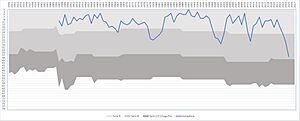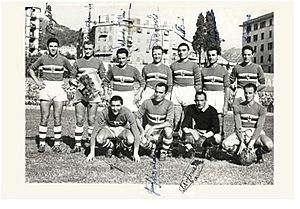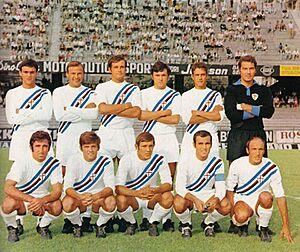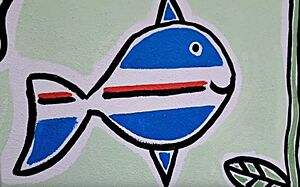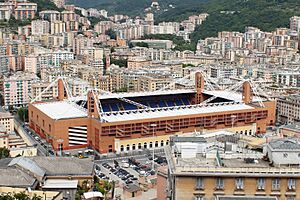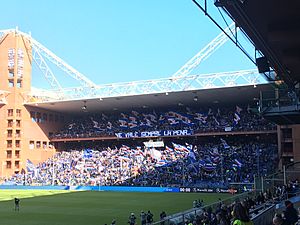UC Sampdoria facts for kids
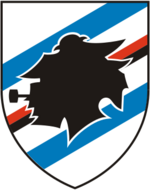 |
|||
| Full name | Unione Calcio Sampdoria S.p.A. | ||
|---|---|---|---|
| Nickname(s) | I Blucerchiati (The Blue-Circled) La Samp Il Doria |
||
| Founded | 12 August 1946, as Unione Calcio Sampdoria | ||
| Ground | Stadio Luigi Ferraris | ||
| Capacity | 33,205 | ||
| Owner | Blucerchiati S.p.A. | ||
| Chairman | Matteo Manfredi | ||
| Head coach | Massimo Donati | ||
| League | Serie B | ||
| 2024–25 | Serie B, 17th of 20 | ||
|
|
|||
Unione Calcio Sampdoria, often called Sampdoria, is a professional football club from Genoa, Italy.
The club was created in 1946. It was formed by joining two older sports clubs: Sampierdarenese and Andrea Doria. These clubs had been around since the 1890s. Sampdoria's name and colors show this union. The name is a mix of the two old clubs. Their unique kit is mostly blue (for Andrea Doria) with white, red, and black stripes (for Sampierdarenese). This is why they are nicknamed blucerchiati, meaning "blue-circled".
Sampdoria plays its home games at Stadio Luigi Ferraris. This stadium can hold 33,205 fans. They share it with another Genoa team, Genoa CFC. The games between these two teams are very exciting. They are known as the Derby della Lanterna.
Sampdoria has won Italy's top league, the Scudetto, once in 1991. They have also won the Coppa Italia four times (1985, 1988, 1989, 1994). In 1991, they won the Supercoppa Italiana too. Their biggest win in Europe was the Cup Winners' Cup in 1990. They also reached the European Cup final in 1992. They lost that game 1–0 to Barcelona after extra time.
Contents
Club History
Early Years: Sampierdarenese and Andrea Doria (1891–1927)
Sampdoria's story began with two teams from the late 1890s. These were Società Ginnastica Sampierdarenese and Società Andrea Doria. Sampierdarenese started its football section in 1899. Andrea Doria, named after a famous Genoese admiral, began in 1895.
Andrea Doria did not join the first Italian Football Championship in 1898. Sampierdarenese was the first of the two to play in the championship in 1900. Andrea Doria joined in 1902. They won their first game in 1907, beating local rivals Genoa 3–1. By 1910–11, Andrea Doria started to play very well. They finished above big teams like Juventus and Internazionale.
After World War I, Sampierdarenese also started playing in the Italian Championship. In 1919–20, Sampierdarenese and Andrea Doria played against each other for the first time. Andrea Doria won the first game. In 1920–21, Andrea Doria finished first in their group.
For the 1921–22 season, Italy's top league split into two. Sampierdarenese joined one league, and Andrea Doria joined the other. Sampierdarenese reached the final of their league. They played against Novese. After two draws, Novese won the replay 2–1 in extra time. By 1924–25, both teams were competing in the Northern League.
From La Dominante to Sampdoria (1927–1946)
In 1927, the Italian government encouraged football teams to merge. This happened all over the country. Sampierdarenese and Andrea Doria merged for the first time. They became a new team called La Dominante.
|
|
||
La Dominante Genova wore green and black striped shirts. They played for only three seasons and were not very successful. In 1929, they played in the first-ever Serie B tournament. They finished third, just missing out on promotion.
Later, La Dominante joined with another local team, Corniglianese. They played as Foot Ball Club Liguria. This team did not do well and was relegated. In 1931, Sampierdarenese and Andrea Doria became separate clubs again. Sampierdarenese quickly moved up from Prima Divisione to Serie B. They then won the 1933–34 Serie B championship. This meant they were promoted to Serie A for the first time.
In 1937, Sampierdarenese merged with Corniglianese and Rivarolese. The club changed its name to Associazione Calcio Liguria. They reached fifth place in Serie A in 1939. After being relegated in the early 1940s, they quickly returned to Serie A.
After World War II, both Andrea Doria and Sampierdarenese were in Serie A. On August 12, 1946, they merged to form Unione Calcio Sampdoria. The new club's first chairman was Piero Sanguineti. Soon, Amedeo Rissotto took over. The team's first coach was Giuseppe Galluzzi. The new kit combined the blue of Andrea Doria with the stripes of Sampierdarenese. The club also started sharing the Stadio Luigi Ferraris stadium with Genoa.
Golden Years: The Mantovani Era (1946–1993)
For about 30 years, Sampdoria played in Serie A. Their best result was fourth place in 1960–61. In 1965–66, they were relegated to Serie B for the first time. But they won the Serie B championship the next year and returned to Serie A right away.
In 1979, Paolo Mantovani, an oil businessman, bought the club. Sampdoria was in Serie B at the time. Mantovani invested a lot to make the team successful. In 1982, Sampdoria returned to Serie A. They won their first Coppa Italia in 1985. In 1986, Vujadin Boškov became the new coach. The club won their second Coppa Italia in 1988. They then played in the 1988–89 UEFA Cup Winners' Cup. They reached the final but lost to Barcelona.
A second Coppa Italia win in a row in 1989 sent Sampdoria to the 1989–90 UEFA Cup Winners' Cup. They won this competition after beating Anderlecht in extra time.
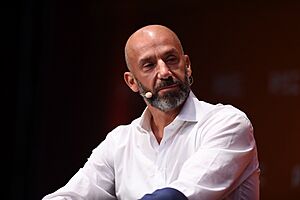
Just one year later, in 1991, they won their first and only Scudetto. They became Serie A champions, finishing five points ahead of Internazionale. The winning team had famous players like Gianluca Pagliuca, Gianluca Vialli, Roberto Mancini, and Attilio Lombardo. Boškov was still the coach. The next season, Sampdoria reached the European Cup final. They lost again to Barcelona at Wembley Stadium. Vujadin Boškov is remembered as one of Sampdoria's most successful coaches.
Changes in Ownership (1993–Present)
On October 14, 1993, Paolo Mantovani passed away. His son, Enrico, took over. In his first season (1993–94), Sampdoria won another Coppa Italia. They also finished fourth in Serie A. Over the next few years, many key players left. But the club bought new talented players. These included Juan Sebastián Verón, Ariel Ortega, and Clarence Seedorf. In 1995, Sampdoria reached the semi-finals of the Cup Winners' Cup. They lost to Arsenal in a penalty shootout. In May 1999, Sampdoria was relegated from Serie A. They did not return to the top league until 2003.
In 2002, Riccardo Garrone, an Italian oil businessman, bought Sampdoria. The team returned to Serie A in 2003. They finished eighth in their first season back. After several good finishes, Walter Mazzarri became manager in 2007. With new players like Antonio Cassano and Giampaolo Pazzini, Sampdoria finished sixth in 2007–08. This qualified them for the 2008–09 UEFA Cup. The next season, they finished fourth. This meant they could play in the UEFA Champions League play-offs.

After their manager and key players left, Sampdoria struggled. They were relegated to Serie B in May 2011. However, in June 2012, Sampdoria won promotion back to Serie A. They beat Varese in the play-off final.
In 2013, Edoardo Garrone took over after his father's death. He wanted to sell the club quickly because of its debts. The sale to Massimo Ferrero in 2014 was not popular with fans. Ferrero was a film producer. In the 2014–15 season, Sampdoria finished seventh. They took a spot in the 2015–16 UEFA Europa League because another team could not get a license. The club stayed strong in Serie A for the next seven years. Managers like Marco Giampaolo and Claudio Ranieri helped. Striker Fabio Quagliarella scored many goals.
However, there were growing problems with Ferrero's leadership. On December 6, 2021, Massimo Ferrero was arrested for business crimes. He resigned as president. The club said the football team's affairs were not part of the investigation. On December 27, former player Marco Lanna became president. In January 2022, former manager Marco Giampaolo returned. Sampdoria won his first home game back. But results got worse, and Giampaolo left after a winless start to the 2022–23 season. On October 6, Dejan Stanković became manager. Sampdoria was relegated from Serie A to Serie B in the 2022–23 season.
In May 2023, new owners, Andrea Radrizzani and Matteo Manfredi, bought Sampdoria. This saved the club from going bankrupt. On June 27, 2023, former Italy star Andrea Pirlo became the manager. The club faced financial difficulties in the 2023–24 season. They qualified for the promotion playoffs but lost in the first round. The 2024–25 season was tough. Despite new players and four manager changes, results were not good. Sampdoria finished 18th, which meant they were set to be relegated to Serie C. However, another team, Brescia, had points taken away. This changed the standings. Sampdoria then played a relegation play-off against Salernitana. They won the play-off 5–0, securing their place in Serie B.
Team Colors, Badge, and Nicknames
Sampdoria's white, blue, red, and black colors show its origins. The two merged teams, Sampierdarenese and Andrea Doria, wore red/black and white/blue jerseys.
The club's badge features a sailor. This sailor is known as Baciccia in the local Genoese dialect. It's a short form of "Giovanni Battista" (John the Baptist). The sailor image is used because Genoa is a major port city. The specific design of Baciccia came from a Disney comic in 1980. Since 1980, the Baciccia has appeared on Sampdoria's shirts. It is usually on the chest, but sometimes on the sleeve.
Home Stadium
Since 1946, Sampdoria has played at the Stadio Luigi Ferraris. It is also called the Marassi, after the neighborhood where it is located. The stadium can hold 33,205 people. It is the ninth-largest stadium in Italy. The stadium is named after Luigi Ferraris. He was an Italian footballer, engineer, and soldier who died during World War I.
Sampdoria shares the stadium with their rivals, Genoa CFC. The stadium was rebuilt before the 1990 FIFA World Cup. It hosted several matches during that World Cup.
Fans and Rivalries
Most Sampdoria fans come from the city of Genoa. The largest fan group is Ultras Tito Cucchiaroni. They are named after an Argentinian player who played for Sampdoria. This group started in 1969, making it one of Italy's oldest fan groups. They do not take political sides. The main support, with flags and flares, comes from the southern part of the stadium, called Gradinata Sud.
Sampdoria's biggest rivals are Genoa. Their matches against each other are called the Derby della Lanterna.
Club Achievements
Italian Trophies
- Serie A
- Winners (1): 1991
- Serie B
- Winners (1): 1967
- Coppa Italia
- Winners (4): 1985, 1988, 1989, 1994
- Supercoppa Italiana
- Winners (1): 1991
European Trophies
- European Cup
- Runners-up (1): 1992
- European Cup Winners' Cup
- Winners (1): 1990
- Runners-up (1): 1989
Friendly Tournaments
- Wembley International Tournament
- Winners (3): 1990, 1991, 1992
- Trofeo Bortolotti
- Winners (2): 1998, 2006
- Amsterdam Tournament
- Winners (1): 1988
- Joan Gamper Trophy
- Winners (1): 2012
Player Records
Most Appearances
These are players who have played the most games for Sampdoria.
| # | Name | Years | Matches |
|---|---|---|---|
| 1 | 1982–1997 | 567 | |
| 2 | 1984–1999 | 501 | |
| 3 | 1983–1995 | 493 | |
| 4 | 2002–2012, 2012–2017 | 459 | |
| 5 | 1983–1992 | 401 | |
| 6 | 1979–1981, 1984–1990, 1993–1998 | 377 | |
| 7 | 1980–1991 | 363 | |
| 8 | 1958–1969 | 353 | |
| 9 | 1954–1965 | 351 | |
| 10 | 1984–1992 | 328 |
Top Goalscorers
These are players who have scored the most goals for Sampdoria.
| # | Name | Years | Goals |
|---|---|---|---|
| 1 | 1982–1997 | 171 | |
| 2 | 1984–1992 | 141 | |
| 3 | 1999–2007 | 110 | |
| 4 | 2006–2007, 2016–2023 | 106 | |
| 5 | 1946–1953 | 89 | |
| 6 | 1946–1950, 1953–1955 | 71 | |
| 7 | 1996–1999, 2007–2008 | 66 | |
| 8 | 1963–1964, 1965–1976 | 55 | |
| 9 | 1955–1958 | 52 | |
| 2013–2015, 2019–2023 | |||
| 10 | 1989–1995, 2001–2002 | 51 |
Current Players
|
|
Sampdoria Youth Team
|
|
Club Officials
Club Presidents
| Name | Period |
|---|---|
| 1946 | |
| 1946–1948 | |
| 1948–1953 | |
| 1953–1961 | |
| 1961–1965 | |
| 1965–1966 | |
| 1966–1968 | |
| 1968–1973 | |
| 1973–1974 | |
| 1974–1978 | |
| 1978–1979 | |
| 1979–1993 | |
| 1993–2000 | |
| 2000–2002 | |
| 2002 | |
| 2002–2013 | |
| 2013–2014 | |
| 2014–2021 | |
| 2021–2024 | |
| 2024– |
Team Managers
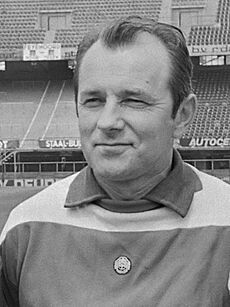
| Period | Name |
|---|---|
| 1946–1947 | |
| 1951 | |
| 1947–1950 | |
| 1950–1951 | |
| 1951 | |
| 1951–1952 | |
| 1952 | |
| 1952–1953 | |
| 1953–1954 | |
| 1954–1956 | |
| 1956–1957 | |
| 1957 | |
| 1957–1958 | |
| 1958 | |
| 1958–1962 | |
| 1962–1963 | |
| 1963–1965 | |
| 1965–1966 | |
| 1966–1971 | |
| 1971–1973 | |
| 1973–1974 | |
| 1974–1975 | |
| 1975–1977 | |
| 1977–1978 | |
| 1978–1979 | |
| 1979–1980 | |
| 1980–1981 | |
| 1981–1984 | |
| 1984–1986 | |
| 1986–1992 | |
| 1992–1997 | |
| 1997 | |
| 1997–1998 | |
| 1998 | |
| 1998–1999 | |
| 1999 | |
| 1999–2000 | |
| 2000–2001 | |
| 2001–2002 | |
| 2002–2007 | |
| 2007–2009 | |
| 2009–2010 | |
| 2010–2011 | |
| 2011 | |
| 2011 | |
| 2011–2012 | |
| 2012 | |
| 2012–2013 | |
| 2013–2015 | |
| 2015 | |
| 2015–2016 | |
| 2016–2019 | |
| 2019 | |
| 2019–2021 | |
| 2021–2022 | |
| 2022 | |
| 2022–2023 | |
| 2023–2024 | |
| 2024 | |
| 2024-2025 | |
| 2025 | |
| 2025- |
Recent Seasons
Here's how the club has performed in recent seasons:
| Season | Division | Tier | Position |
| 1995–96 | Serie A | I | 8th |
| 1996–97 | Serie A | 6th | |
| 1997–98 | Serie A | 9th | |
| 1998–99 | Serie A | 16th ↓ | |
| 1999–2000 | Serie B | II | 5th |
| 2000–01 | Serie B | 6th | |
| 2001–02 | Serie B | 11th | |
| 2002–03 | Serie B | 2nd ↑ | |
| 2003–04 | Serie A | I | 8th |
| 2004–05 | Serie A | 5th | |
| 2005–06 | Serie A | 12th | |
| 2006–07 | Serie A | 9th | |
| 2007–08 | Serie A | 6th | |
| 2008–09 | Serie A | 13th | |
| 2009–10 | Serie A | 4th | |
| 2010–11 | Serie A | 18th ↓ | |
| 2011–12 | Serie B | II | 6th ↑ |
| 2012–13 | Serie A | I | 14th |
| 2013–14 | Serie A | 12th | |
| 2014–15 | Serie A | 7th | |
| 2015–16 | Serie A | 15th | |
| 2016–17 | Serie A | 10th | |
| 2017–18 | Serie A | 10th | |
| 2018–19 | Serie A | 9th | |
| 2019–20 | Serie A | 15th | |
| 2020–21 | Serie A | 9th | |
| 2021–22 | Serie A | 15th | |
| 2022–23 | Serie A | 20th ↓ | |
| 2023–24 | Serie B | II | 7th |
| 2024–25 | Serie B | II | 17th |
| 2025–26 | Serie B | II |
- Key
| ↑ Promoted | ↓ Relegated |
League History
| Series | Years | Last | Promotions | Relegations |
|---|---|---|---|---|
| A | 65 | 2022–23 | - | |
| B | 12 | 2024–25 | ||
| 79 years of professional football in Italy since 1946 | ||||
World Cup Winners
 Alain Boghossian (France 1998)
Alain Boghossian (France 1998) Shkodran Mustafi (Brazil 2014)
Shkodran Mustafi (Brazil 2014)
See also
 In Spanish: Unione Calcio Sampdoria para niños
In Spanish: Unione Calcio Sampdoria para niños


